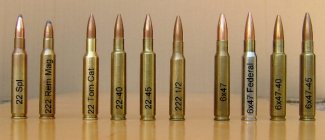If you’ve followed my threads on Competition Cartridges you may have noticed a trend. Does it seem to you that many have U.S. military connections? Well you aren’t imagining it because it’s true. The one that follows is no exception.
In the early 1950s, Springfield Armory envisioned a small caliber, light infantry weapon for the future. In a joint effort with the Aberdeen Proving Ground and Remington Arms they designed and constructed a couple of custom rifles and a quantity of ammunition for testing. Essentially a longer version of the brand new 222 Remington, the cartridge was unofficially called the “22 Specialâ€. Remington used a conventional 55 grain SP hunting type bullet for the tests. Results were very encouraging.
But during this same time, Frankford Arsenal was developing a short and light 30 caliber weapon system and cartridge that it hoped to sell to NATO countries. ,See my thread on the origins of the 308 Winchester) Other NATO members favored a small caliber weapon and the Army was fearful that the 22 Special would compromise their push for the 30 caliber and so they instructed Springfield Armory to abandon their project. Since Remington had been a cooperative in the project they were given permission to market the new cartridge commercially if they so wished. They did eventually, and today we know it as the 222 Remington Magnum.
Any new cartridge is an automatic candidate for wildcatting and the 222 Remington Magnum was no exception. Even though the 222 Remington was able to deliver all the goods in short-range Benchrest, there were shooters who thought they could do better.,Sound familiar?) There isn’t much that can be done to a cartridge the size of the 222 Remington Magnum but all of it was done. The shoulder angle was increased to 30,22 Tom Cat), then 40,22-40), then 45 degrees,22-45). When that limit was reached they went in the other direction, shortened it and called it the 222 ½. Since the Sporter Class required a cartridge not less than .23 caliber, the 222 Remington Magnum was simply expanded to .243 and the 6x47 was born. It too was “improved†by increasing the shoulder angle to 40,6x47-40) and then 45 degrees,6x47-45).
In the end, the only truly successful competition cartridge based on the 222 Remington Magnum was the original 6x47. Federal actually produced new, nickeled brass with a 6x47 headstamp. But it was only a few years until the newfangled PPC cartridges appeared and all the 222 Remington Magnum based cartridges became a part of ancient history. And here they are.
In the early 1950s, Springfield Armory envisioned a small caliber, light infantry weapon for the future. In a joint effort with the Aberdeen Proving Ground and Remington Arms they designed and constructed a couple of custom rifles and a quantity of ammunition for testing. Essentially a longer version of the brand new 222 Remington, the cartridge was unofficially called the “22 Specialâ€. Remington used a conventional 55 grain SP hunting type bullet for the tests. Results were very encouraging.
But during this same time, Frankford Arsenal was developing a short and light 30 caliber weapon system and cartridge that it hoped to sell to NATO countries. ,See my thread on the origins of the 308 Winchester) Other NATO members favored a small caliber weapon and the Army was fearful that the 22 Special would compromise their push for the 30 caliber and so they instructed Springfield Armory to abandon their project. Since Remington had been a cooperative in the project they were given permission to market the new cartridge commercially if they so wished. They did eventually, and today we know it as the 222 Remington Magnum.
Any new cartridge is an automatic candidate for wildcatting and the 222 Remington Magnum was no exception. Even though the 222 Remington was able to deliver all the goods in short-range Benchrest, there were shooters who thought they could do better.,Sound familiar?) There isn’t much that can be done to a cartridge the size of the 222 Remington Magnum but all of it was done. The shoulder angle was increased to 30,22 Tom Cat), then 40,22-40), then 45 degrees,22-45). When that limit was reached they went in the other direction, shortened it and called it the 222 ½. Since the Sporter Class required a cartridge not less than .23 caliber, the 222 Remington Magnum was simply expanded to .243 and the 6x47 was born. It too was “improved†by increasing the shoulder angle to 40,6x47-40) and then 45 degrees,6x47-45).
In the end, the only truly successful competition cartridge based on the 222 Remington Magnum was the original 6x47. Federal actually produced new, nickeled brass with a 6x47 headstamp. But it was only a few years until the newfangled PPC cartridges appeared and all the 222 Remington Magnum based cartridges became a part of ancient history. And here they are.











